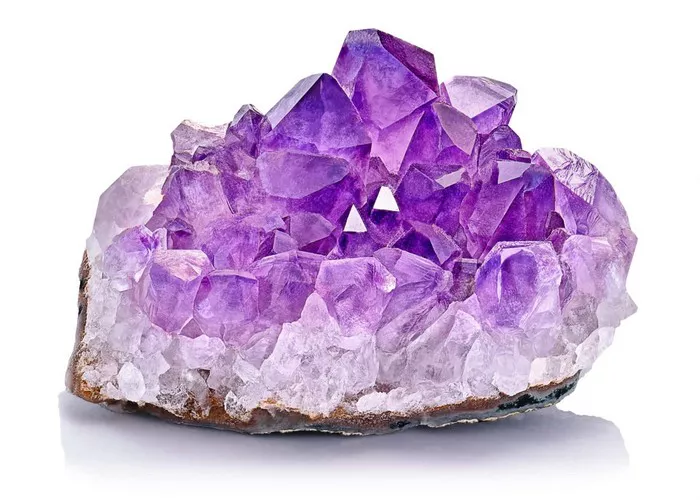Simulated amethyst is a term used to describe stones crafted to mimic the appearance of real amethyst gems. Despite their visual similarity to genuine amethyst, simulated stones possess different chemical compositions and physical properties. These stones are created intentionally to replicate the allure of natural amethyst but are distinct in their origin and characteristics.
Comparison with Natural Amethyst:
Natural Amethyst: Natural amethyst is formed in nature without any human intervention. It is typically mined from the earth or discovered in water sources. The process of its formation involves geological phenomena over extensive periods, resulting in the distinct crystalline structure and vibrant hues that characterize genuine amethyst. Due to its natural occurrence, genuine amethyst is relatively rare and commands higher prices in the market.
Simulated Amethyst: In contrast, simulated amethyst is produced within controlled laboratory environments. While it mirrors the appearance of natural amethyst, its creation involves human intervention, employing techniques to replicate the crystalline structure and coloration of authentic amethyst. The controlled conditions under which simulated amethyst is grown ensure consistency in quality and appearance, making it more accessible and affordable compared to its natural counterpart.
Synthetic vs. Simulated:
It’s essential to distinguish between synthetic and simulated gemstones:
Synthetic Gemstones: Synthetic gemstones are laboratory-grown counterparts of natural gemstones. They possess identical crystal structures and chemical compositions to their natural counterparts. These gems are cultivated under controlled conditions that mimic the natural processes of gemstone formation. While synthetic gemstones offer affordability and ethical sourcing, they lack the rarity associated with natural gemstones.
Simulated Gemstones: Simulated gemstones, on the other hand, are imitations crafted to resemble genuine gemstones. Unlike synthetics, simulated gems have different chemical compositions and properties compared to their natural counterparts. While they may replicate the visual appearance of real gemstones, they are distinct in their origin and composition. Simulated gemstones provide an accessible option for those seeking the aesthetic appeal of natural gemstones without the associated cost.
Methods of Creating Simulated Amethyst:
Several techniques are employed in the creation of simulated amethyst:
Flame Fusion: This method involves melting chemical compounds and allowing them to solidify into crystal structures resembling amethyst.
Crystal Pulling: In crystal pulling, a seed crystal is immersed in a molten solution, allowing the formation of a larger crystal structure over time.
Flux Growth: Flux growth involves dissolving chemical compounds in a flux medium and allowing crystallization to occur under controlled conditions.
Hydrothermal Growth: Hydrothermal growth utilizes high-pressure, high-temperature conditions to facilitate the growth of crystals, mimicking natural geological processes.
These techniques enable the controlled production of simulated amethyst, ensuring consistency in quality and appearance.
Visual Inspection and Gemologist Expertise:
Trained gemologists possess the expertise to distinguish between simulated and genuine gemstones. Through visual inspection and specialized testing equipment, gemologists can identify subtle differences in properties such as refractive index, specific gravity, and spectral characteristics. Additionally, experienced gemologists can recognize the distinct features of simulated gemstones that differentiate them from their natural counterparts.
Common Simulated Gemstones:
In addition to simulated amethyst, various other gemstones are commonly simulated:
Diamond: Synthetic diamonds and cubic zirconia are frequently used as diamond simulants due to their optical properties.
Emerald: Glass and synthetic spinel are often utilized to imitate the vibrant green hues of natural emeralds.
Ruby: Synthetic corundum and glass are commonly employed to replicate the intense red coloration of natural rubies.
Sapphire: Synthetic sapphire and blue glass are popular choices for simulating the deep blue tones of natural sapphires.
Citrine: Heat-treated amethyst or quartz is often marketed as citrine, simulating its golden-yellow coloration.
Garnet: Glass and synthetic garnets are used to imitate the rich red hues of natural garnet gemstones.
Spinel: Synthetic spinel and glass are frequently utilized as simulants for natural spinel gemstones.
These simulants offer cost-effective alternatives to genuine gemstones while providing similar aesthetic appeal.
Legal Requirements:
In the United States, there are legal regulations governing the disclosure of gemstone origin. It is mandatory for sellers to disclose whether a gemstone is natural, synthetic, or simulated. This ensures transparency in the gemstone trade and allows consumers to make informed purchasing decisions. While genuine gemstones may undergo treatments to enhance their appearance or durability, they are still naturally occurring and distinct from simulated or synthetic counterparts.
In conclusion, simulated amethyst and other gemstones serve as compelling alternatives to their natural counterparts. While they may lack the rarity and geological significance of genuine gemstones, simulated gems offer affordability, consistency, and accessibility. By understanding the distinctions between natural, synthetic, and simulated gemstones, consumers can make informed choices when selecting gemstone jewelry or decorative pieces.


